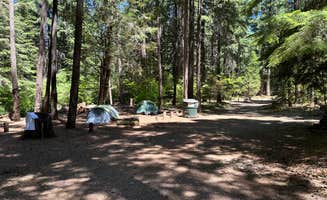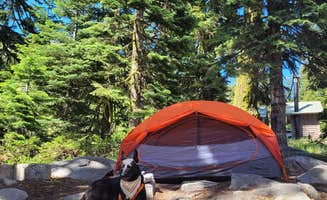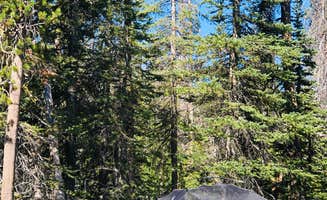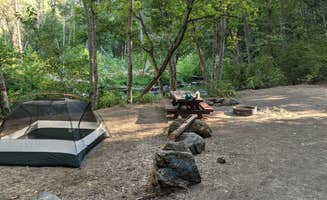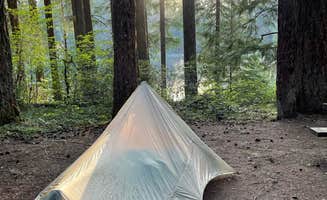Dispersed camping near Butte Falls, Oregon offers remote sites across Rogue River National Forest at elevations between 2,500-6,000 feet. Most primitive camping options remain accessible from late spring through mid-autumn, with forest roads typically clear of snow by May. Weather can change rapidly in this mountainous region, with temperature drops of 20+ degrees common after sunset even during summer months.
What to do
Fishing opportunities: USFS Rogue River Dispersed camping provides access to trout fishing along the Rogue River. "We took a right and found multiple sites to pull into right off the main forest service road... if you're into fishing the Rogue River is very close," notes one USFS Rogue River Dispersed camper.
Hiking access: Camping at Mount Ashland puts you near multiple trails including the Pacific Crest Trail. "The PCT runs near here so it is a place for thru hikers to stay," explains a Mount Ashland visitor. Trails range from moderate day hikes to challenging multi-day treks.
Wildlife viewing: Early mornings at primitive sites often yield wildlife sightings. One camper at Mount Ashland Campground reported: "Had deer running around while I was setting up the tent." Dawn and dusk provide best viewing opportunities when animals are most active.
What campers like
High elevation cooling: Summer heat relief comes from camping at higher elevations. "The cooler temperatures are great," notes a Mount Ashland camper about the climate advantages. Sites above 5,000 feet can be 15-20 degrees cooler than valley locations during hot summer months.
Stargazing: Clear mountain air provides exceptional night sky viewing. A Mill Creek Campground visitor shared: "It was beautiful being immersed in the forest right along the creek." Many dispersed sites offer unobstructed sky views away from light pollution.
Solitude: Primitive sites offer privacy and quiet compared to developed campgrounds. "We were the only ones using this site in mid October, it was beautiful," mentions a Mill Creek camper. Weekday camping, especially in shoulder seasons, provides the best chance for solitary experiences.
What you should know
Water availability: Most dispersed camping areas lack potable water. A Parker Meadows review states it offers "Primitive camping, needs maintenance, but wild and close to wilderness trails." Always bring sufficient water or water filtration equipment.
Road conditions: Access roads to many sites require careful driving. "Title refers to the potholes. Lots of potholes!" warns one USFS Rogue River Dispersed camper. High-clearance vehicles perform better on the unpaved forest roads leading to remote sites.
Temperature fluctuations: Be prepared for dramatic temperature drops. "It is WINDY and I mean, drops 20 degrees windy, rocks the van windy," cautions a Mount Ashland visitor. Pack layers regardless of season as mountain weather changes quickly.
Tips for camping with families
Creek-adjacent sites: Camping near water features engages children. Mill Creek Campground offers stream-side sites where kids can explore safely. "Each spot had a picnic table and fire pit, with a good amount of flat space for a tent or vehicle," notes a visitor to Mill Creek Campground.
Easier access options: With children, consider sites with minimal hiking. "If you are looking just for a quick site to get in and out of, this is it," recommends a USFS Rogue River Dispersed camper about certain drive-up spots suitable for families with small children.
Wildlife education: Turn animal encounters into learning opportunities. A camper at Willow-Witt Ranch mentioned unique wildlife interactions suitable for children's education. Many sites have interpretive materials available during peak season.
Tips for RVers
Size restrictions: Larger rigs face limitations at most primitive sites. "The place to park for vehicles is far from level. Even with camper jacks I was sleeping at an angle," warns a Jim Creek Group Campground visitor. Most dispersed sites accommodate vehicles under 25 feet best.
Leveling challenges: Bring leveling equipment for uneven parking. "RVs or trailers would have a hard time finding a spot that would fit them, though we saw one or two that a small rig could squeeze into," notes a camper describing Mount Ashland's terrain limitations.
Turnaround space: Scout ahead before committing to narrow forest roads. "It is advisable to walk up the road to assess to see if your rig has a space or will even fit," suggests a Mount Ashland visitor. Many forest roads lack adequate turnaround space for larger vehicles.


